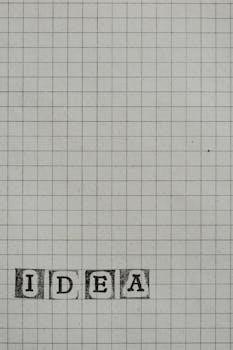
Lettering guide templates are specialized tools used to create uniform characters, often in technical drawings․ These templates feature cut-outs of letters, numbers, and symbols, typically made from plastic or acrylic․ They aid in producing consistent lettering․
Definition and Purpose of Lettering Templates
Lettering templates are physical guides, usually made of transparent plastic, with precisely cut-out shapes of letters, numbers, and symbols․ Their primary purpose is to facilitate the creation of consistent, legible text, especially in technical drawings, architectural plans, and other professional documents․ These templates eliminate the need for freehand lettering, ensuring uniform height, width, and spacing, which is crucial for clarity and professional appearance․ They also help avoid smearing ink and wrinkling paper, making them an essential tool for precise lettering․

Types of Lettering Guide Templates
Lettering templates come in various forms, including standard templates for technical drawings and specialized templates for calligraphy and hand lettering․ These cater to different needs, ensuring accuracy or artistic expression;
Standard Lettering Templates for Technical Drawings
Standard lettering templates for technical drawings are designed to ensure uniformity and legibility in architectural and engineering documents․ These templates typically feature uppercase letters, numbers, and common symbols conforming to standards like ISO 3098․ They often have precise cutouts and pencil allowances for technical pens, ensuring consistent line width․ These templates are crucial for accurate dimensioning and labeling in technical projects, making them indispensable for professionals․
Specialized Templates for Calligraphy and Hand Lettering
Specialized templates for calligraphy and hand lettering offer varied styles and sizes beyond standard technical fonts․ These templates often include guidelines for slants, spacing, and decorative elements to aid in creating artistic lettering․ They can incorporate different font styles, such as script or modern bold, and include guides for flourishes and other embellishments․ These tools assist both beginners and experienced artists in achieving consistent and aesthetically pleasing results in their lettering projects․
Key Features of Lettering Guide Templates
Key features include material durability, often using transparent acrylic, and precise letter size and spacing options․ Templates have cut-outs for various letter heights, typically ranging from 1/8 to 1/4 inch, with some designed for specific pen sizes․
Material and Durability
Lettering guide templates are commonly crafted from durable, transparent materials like acrylic or impact-modified plastic․ These materials offer stability and clarity, allowing users to see the underlying surface while working․ The templates are designed to be robust and non-warping, ensuring they maintain their shape and accuracy with repeated use․ This durability is essential for professionals who rely on consistent results in drafting and design projects, providing a long-lasting tool for lettering․
Letter Size and Spacing
Lettering guide templates feature various cut-out sizes, often including 1/8, 5/32, 3/16, and 1/4 inch slots, designed to accommodate different lettering needs․ Some templates include multiple sizes within a single tool․ Spacing between letters is often standardized, sometimes with guidelines for equidistant spacing․ These features enable users to maintain consistent letter height and spacing, ensuring legibility and uniformity in technical drawings, crafts and design projects․
Using Lettering Guide Templates Effectively
Effective use requires proper alignment with existing guidelines or reference points․ Ensure the template is stable to avoid smudging․ Use appropriate pencils or pens with the correct lead or nib size for accurate results․
Proper Alignment and Placement
Proper alignment and placement are crucial for achieving professional-looking results with lettering templates․ Begin by carefully positioning the template on the drawing surface, ensuring it’s parallel to any existing guidelines or reference points․ Use centering lines, if available on the template, to accurately place letters within a given space․ Consistent alignment prevents a sloppy or unprofessional appearance․ Proper spacing is also important for readability, so be sure to utilize the template’s guides for uniform letter spacing․
Pencil and Pen Compatibility
Lettering templates are designed to work with a variety of pencils and pens, though compatibility is key to achieving clean lines․ Many templates feature pencil allowances, specifically for 0․5mm pencil leads, ensuring the lead fits snugly within the cutouts․ For inking, beveled edges on the template prevent ink from bleeding or smudging․ It is important to use pens with appropriate line widths to match the template’s design, typically technical pens, to ensure your lettering is crisp and precise․ Choosing the correct pen or pencil is crucial for optimal results․

Standards and Specifications
Lettering templates often adhere to standards like ISO 3098, which specifies lettering height and width ratios․ For instance, a 3․5mm stencil has lettering 3․5mm high, with corresponding pen widths․ BIS also provides guidelines for lettering styles․
ISO 3098 Standard for Lettering Height and Width
The ISO 3098 standard is a crucial guideline for lettering templates, particularly in technical drawing․ This standard dictates the relationship between the height and width of letters, ensuring uniformity and legibility․ Specifically, the standard often specifies that the lettering height should be ten times the lettering width․ For example, a stencil designed for 3․5mm lettering would have a 3․5mm height and accommodate a pen with a 0․35mm line width, maintaining a 10⁚1 ratio as set by the standard․
BIS Specifications for Lettering Styles
BIS, or the Bureau of Indian Standards, also provides specifications for lettering styles, often focusing on the line thickness relative to the letter width․ These specifications, much like the ISO standards, ensure consistency and clarity in technical documents and drawings․ BIS guidelines typically define the standard width of letters based on the thickness of the line used for lettering, leading to distinct lettering styles such as ‘A’ and ‘B’․ These guidelines are essential for maintaining uniformity and readability in technical writing․
Where to Find Lettering Guide Templates
Lettering guide templates can be found at retailers specializing in drafting supplies, like FLAX, as well as online marketplaces․ Options range from basic to specialized templates․ These are available on sites like Amazon․
Retailers Specializing in Drafting Supplies
Stores like FLAX are excellent resources for finding a variety of lettering guide templates․ These retailers often carry templates designed for professional use, including those adhering to ISO standards․ You can expect to find a range of materials, sizes, and styles, catering to both basic drafting needs and more specialized calligraphy or hand lettering projects․ They usually have knowledgeable staff to assist in selecting the right template․
Online Marketplaces
Online marketplaces like Amazon offer a vast selection of lettering guide templates from various brands․ You can find options ranging from basic templates for technical drawings to specialized ones for calligraphy and design projects․ These platforms often feature customer reviews, which can help you assess the quality and suitability of different templates․ Also, you can compare prices and find both individual templates and sets․

Benefits of Using Lettering Guide Templates
Lettering guide templates ensure uniformity and legibility in lettering․ They save time and increase efficiency by eliminating the need for manual guidelines and ensuring that letters are perfectly formed and consistent․
Ensuring Uniformity and Legibility
Lettering guide templates are crucial for achieving consistent and readable text, particularly in technical documents․ These templates ensure that every character maintains the same size, shape, and spacing, eliminating variations that can hinder clarity․ By providing a standardized approach, they greatly improve the overall professionalism and ease of understanding of written content, especially in fields like engineering and architecture where precision is paramount․
Time-Saving and Efficiency
Utilizing lettering guide templates significantly reduces the time and effort required for creating neat and consistent text․ These templates eliminate the need to draw guidelines or correct uneven characters, streamlining the lettering process․ They enable users to quickly produce standardized lettering, boosting productivity and allowing more time to focus on other aspects of a project, whether it’s drafting, design, or crafting․

Applications of Lettering Guide Templates
Lettering guide templates are widely used in architectural and engineering drawings for labeling dimensions and notes․ They also find use in craft and design projects, ensuring consistent text․
Architectural and Engineering Drawings
In architectural and engineering fields, lettering templates are indispensable for creating clear and uniform text on blueprints and technical documents․ These templates ensure that dimensions, labels, and notes are consistently legible, adhering to industry standards like ISO 3098․ The use of lettering guides helps maintain precision and professionalism, vital for accurate communication among professionals․ They assist in writing clear, standardized characters and are crucial for technical accuracy․
Craft and Design Projects
Lettering guide templates are also valuable tools for various craft and design projects․ Whether creating custom labels, signs, or graphic designs, these templates help ensure characters are perfectly formed and consistent․ They assist hobbyists and designers in achieving professional-looking results in their projects, offering precision and uniformity․ Templates can be used for hand lettering, calligraphy, and even journaling, supporting various creative endeavors with easy to use guides․